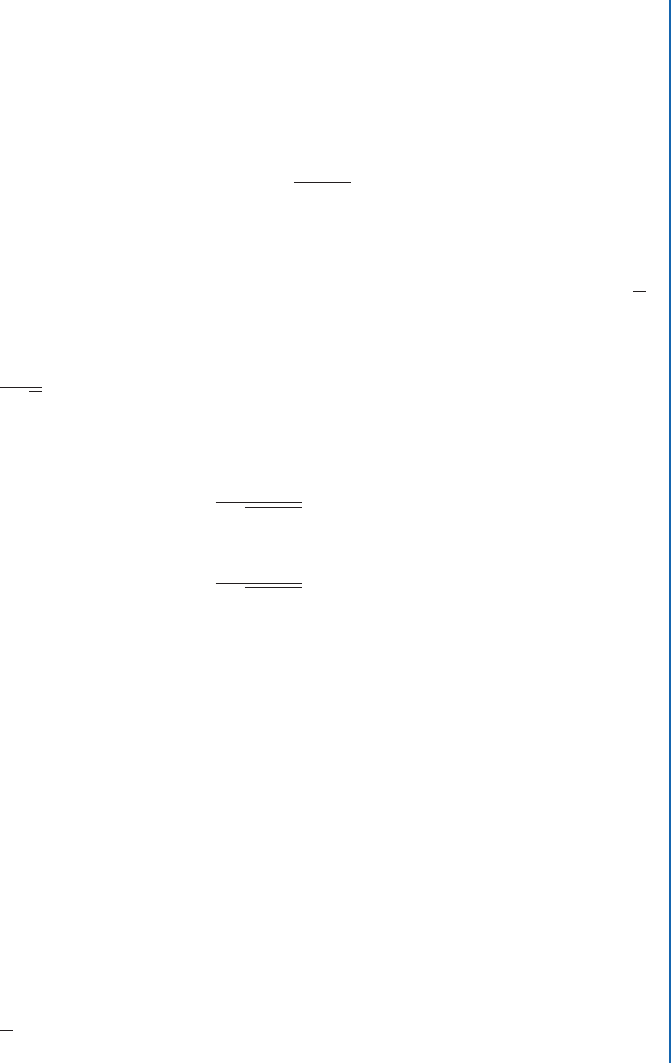
3.4. THE PRODUCT, QUOTIENT, RECIPROCAL, AND CHAIN RULES 109
3.4.1 FUNCTIONAL COMPOSITION AND THE CHAIN RULE
e composition of two functions results from applying one to the other. If the functions are
f .x/ and g.x/, then their composition is written f .g.x//. Let’s look at a few examples.
Example 3.61 If f .x/ D x C 7 and g.x/ D x
2
, then
f .g.x// D x
2
C 7
while
g.f .x// D .x C 7/
2
˙
Example 3.62 If f .x/ D sin.x/ and g.x/ D e
x
, then
f .g.x// D sin
.
e
x
/
while
g.f .x// D e
sin.x/
˙
e order in which two functions are composed matters a lot—the results are not symmetric.
e chain rule is used to compute the derivative of a composition of functions.
Knowledge Box 3.15
e chain rule
.
f .g.x//
/
0
D f
0
.g.x// g
0
.x/
In the composition f .g.x// we call f .x/ the outer function and g.x/ the inner function.
Example 3.63 Compute the derivative of h.x/ D e
2x
.
110 3. LIMITS, DERIVATIVES, RULES, AND THE MEANING OF THE DERIVATIVE
Solution:
Apply the chain rule to the functional composition for which the outer function is f .x/ D e
x
,
and the inner function is g.x/ D 2x. For these, f
0
.x/ D e
x
and g
0
.x/ D 2. So:
h
0
.x/ D e
2x
2
D 2e
2x
˙
Example 3.64 Compute the derivative of q.x/ D sin
x
2
.
Solution:
Apply the chain rule to the functional composition for which the outer function is f .x/ D
sin.x/, and the inner function is g.x/ D x
2
. For these, f
0
.x/ D cos.x/ and g
0
.x/ D 2x. So:
q
0
.x/ D cos
x
2
2x
D 2x cos
x
2
˙
e chain rule avoids a whole lot of multiplying out in some cases. Technically, we could do the
following example without the chain rule, but it would be purely awful.
Example 3.65 Compute the derivative of r.x/ D
x
2
C x C 1
7
.
Solution:
Apply the chain rule to the functional composition for which the outer function is f .x/ D x
7
,
and the inner function is g.x/ D x
2
C x C 1.
For these, f
0
.x/ D 7x
6
and g
0
.x/ D 2x C 1.
So:
r
0
.x/ D 7
x
2
C x C 1
6
.
2x C 1
/

3.4. THE PRODUCT, QUOTIENT, RECIPROCAL, AND CHAIN RULES 111
Normally we don’t multiply out answers like this.
˙
Example 3.66 Compute the derivative of a.x/ D
p
e
x
C 2.
Solution:
Apply the chain rule to the functional composition for which the outer function is f .x/ D
p
x,
and the inner function is g.x/ D e
x
C 2.
For these, f
0
.x/ D
1
2
p
x
and g
0
.x/ D e
x
.
So:
a
0
.x/ D
1
2
p
e
x
C 2
e
x
D
e
x
2
p
e
x
C 2
˙
Example 3.67 Compute the derivative of b.x/ D ln.cos.x//.
Solution:
Apply the chain rule to the functional composition for which the outer function is f .x/ D ln.x/,
and the inner function is g.x/ D cos.x/.
For these, f
0
.x/ D
1
x
and g
0
.x/ D sin.x/.

112 3. LIMITS, DERIVATIVES, RULES, AND THE MEANING OF THE DERIVATIVE
So:
b
0
.x/ D
1
cos.x/
.sin.x//
D
sin.x/
cos.x/
D
sin.x/
cos
.x/
D tan.x/
Notice how simplifying this answer requires one of the simpler trig identities.
˙
With the product, quotient, reciprocal, and especially the chain rule, the variety of functions
for which we can take the derivative is extended substantially. Practice is needed to develop a
sense of which rule to use when.
PROBLEMS
Problem 3.68 Find the derivatives of the following functions with the product rule. You will
need the chain rule for some of these.
1. f .x/ D x cos.x/
2. g.x/ D sin.x/ cos.x/
3. h.x/ D x
5
.x C 1/
6
4. q.x/ D x
3
e
2x
5. r.x/ D tan.x/ ln.x/
6. s.x/ D x
5
tan
1
.x/
7. a.x/ D cos.2x/e
3x
8. b.x/ D cos.x/ sin.ex/

3.4. THE PRODUCT, QUOTIENT, RECIPROCAL, AND CHAIN RULES 113
Problem 3.69 Find the derivatives of the following functions with the quotient rule.
1. f .x/ D
2x C 1
x
3
C 2
2. g.x/ D
ln.x/
1 x
3. h.x/ D
.x C 1/
3
.x 1/
3
4. q.x/ D
tan.x/
cos.x/ C 1
5. r.x/ D .e
x
/=.1 C e
x
/
6. s.x/ D
x
2
C 1
x
2
C x C 1
7. a.x/ D
sin.x/
cos.x/ C 1
8. b.x/ D tan
1
.x/=.x
2
1/
Problem 3.70 Find the derivatives of the following functions with the reciprocal rule.
1. f .x/ D
1
x
2
C 1
2. g.x/ D
1
cos.x/
3. h.x/ D
1
p
2x C 1
4. q.x/ D e
x
5. r.x/ D
1
sin.x/ C cos.x/
6. s.x/ D
1
ln.x/
Problem 3.71 Find the derivatives of the following functions with the chain rule.
1. f .x/ D
x
2
C 1
11
2. g.x/ D cos
x
2
C 1
3. h.x/ D .cos.x/ C 1/
5
4. q.x/ D
p
cos.x/ C 1
5. r.x/ D
1
x
C 1
4
6. s.x/ D e
x
2
CxC1
7. a.x/ D ln
x
3
C 2x
2
C 7x C 5
8. b.x/ D e
tan.x/
9. c.x/ D ln.tan.x//
10. d.x/ D ln
.
e
x
C 1
/
..................Content has been hidden....................
You can't read the all page of ebook, please click here login for view all page.
